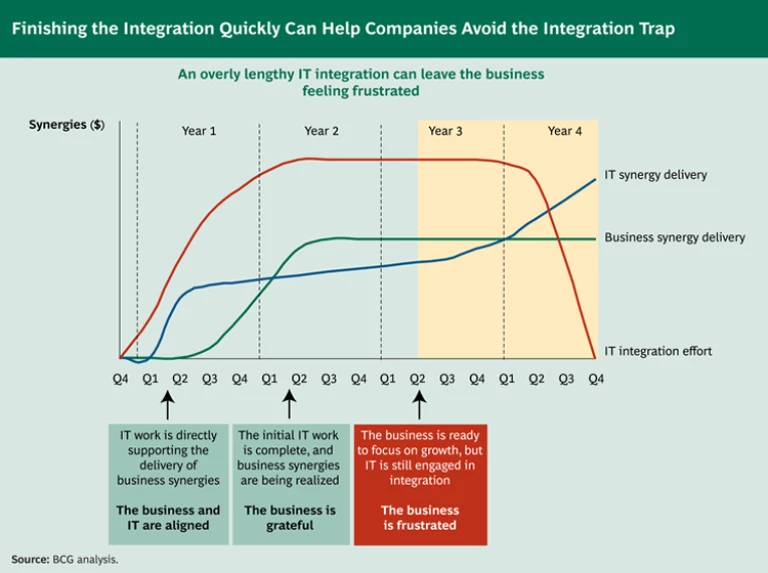Mergers, both forced and unforced, will remain a common event for the foreseeable future—and IT integration will be one of the key factors that determine whether those mergers ultimately deliver the targeted benefits. Most companies know this and focus on it. Still, the results typically fall short and the same questions arise repeatedly:
- Why does the IT integration never seem complete despite an enormous amount of spending?
- Why are IT synergies never fully delivered?
- Why does the business feel more constrained than it did before the integration?
This is not to suggest that IT postmerger integration (PMI) is simple. On the contrary, it is a disruptive, time-consuming, complex, and expensive process, as well as a psychological and emotional trauma for those involved. Yet it is a navigable challenge if companies approach it comprehensively and systematically.
Sadly, though, most companies don’t. Most never adequately address the “hard” side of the integration, failing to make the necessary systems decisions, identify cost targets, and develop implementation plans. One company that decided not to establish cost targets up front had to revisit that decision when it became clear that the proposed integration solutions were unaffordable. Another company’s IT organization neglected to bring the business side on board and was surprised when key platform decisions were reversed. Yet another IT organization was unable to deliver the targeted synergies because of poor tracking of results.
Even more common is the failure to address the "soft," or people, side of the integration. A large-scale IT integration is particularly problematic. Management teams are changing, cultures are clashing, and there is no clarity regarding who will have a role going forward. At the same time, people are being asked to execute the largest change program they have ever contemplated. Firms that do not address these issues virtually guarantee themselves failure.
Companies can and should do better. We outline below the elements of a successful postmerger IT integration. These encompass both the hard and soft sides of the process and are tailored to the CIO of the new organization, who has a unique vantage point and is ultimately the key determinant of whether the effort succeeds or falls short.
The Seven Elements of a Successful IT Integration
Neglecting to properly assess progress is a root cause of failure in IT integration. Many of the usual systems and processes are no longer relevant and things can change by the hour, with today’s success or failure often incorrectly coloring the CIO’s longer-term view. What’s needed is a lens that allows the CIO to step back, escape the day-to-day noise, and see the big picture—to determine where things really stand and what key actions are necessary to get back on course. The elements below can serve as that lens, allowing CIOs to assess where they are and take the appropriate actions to bring the integration back on track.
Element 1: The Targeted Synergies Are Achieved Without Compromises
Achieving IT synergies is seemingly a relatively simple process: cut the development budget and reduce operational manpower. The relationship between integration activity and synergies is often poorly understood, however. And if synergies are not carefully thought through, problems in service and change capabilities can quickly emerge, creating long-lasting business issues. On the other hand, costs can quickly spiral out of control as the business tries to transform its capabilities and IT uses the business’s transformation effort as an opportunity to upgrade.
To make sure that the targeted synergies are realized, CIOs should plan to do the following:
- Think through the overall approach and set initial synergy targets before the integration begins.
- Make sure up front that all critical personnel understand and agree on the business needs and the key decisions (for example, regarding platform choices) that will drive synergies.
- Ensure that it is apparent to all from the outset where the synergies are coming from and that the business side understands the implications for IT changes and service.
- Be specific and clear regarding the timing of the delivery of synergies, particularly when those synergies involve reducing head count. Make sure that issues like software capitalization are fully taken into account.
- Confirm with budget holders that cost and service targets are locked into budgets. There is no such thing as being too granular here. If a savings target is not linked to a specific team and assigned to a budget, the savings will never occur.
- Tightly link costs—on both the business and IT sides—with synergies, and apply normal hurdle rates to ensure that progress stays on track.
- Make sure that suppliers understand what is expected in terms of integration activities and reductions in operating costs. Conversations with suppliers are often fragmented during integration efforts, and suppliers are sometimes able to win significant projects without committing to their own synergy targets.
Element 2: The New IT Organization Is Formed with No Loss of Key Talent
When faced with an uncertain future, the best people start looking at other options. It is essential, therefore, to take proactive steps to retain key IT talent. In one recent IT integration that we observed, nearly all of the best people two layers from the CIO in the acquired company departed. This left the merged organization with vacancies in roughly 33 percent of the positions at a vital level in the organizational structure.
To retain the right talent, CIOs can take several actions:
- As early as possible, identify critical people—both managers and those with essential knowledge—in the target and transition organizations and assure them of their future roles. Like Gothic cathedrals with lost floor plans, internally developed IT systems are often inadequately documented. The resignation of a single middleware expert can bring the work stream to a grinding halt because a desperately needed skill set is now missing.
- Put retention plans in place to secure critical people. Monetary rewards remain the strongest incentive (and are often relatively cheap versus the cost of replacing skills), but direct communication is also important. Inviting key people for 15-minute face-to-face chats with the CIO may be all that is required to reassure and retain them.
- Make sure that the leadership team is committed and visible, with both organizations’ teams closely aligned.
- Be careful in choosing people for roles. Maintaining a balance between the two organizations can be very important.
Element 3: Systems Integration Decisions Are Made Quickly and Perceived as Fair
In our experience, it is crucial to make systems decisions quickly and transparently. Very often, this is the point at which a psychological chess match ensues between rival organizations fighting for relevance, each with its own scoring systems and means of justification. Unless this infighting is curtailed, progress will be delayed and questions will linger.
CIOs can prevent the chess match by taking the following actions:
- Establish straightforward principles for systems selection up front—for example, “the acquirer’s systems will be used unless there will be major business harm in doing so”—and get buy-in. These principles should be consistent with the proposed new operating model.
- Put in place a clear process for making choices, one that is not mired in detail but is sufficiently explicit to be seen as fair and transparent: we are not flipping a coin but nor are we comparing lines of code.
- Make sure that specific choices are made quickly, that all parties sign off, and that the rationale is communicated.
- Where possible, focus on integration, not transformation. Sometimes there is no choice but to press forward with a transformation effort as well, but the full consequences (in terms of both cost and time) need to be understood.
Element 4: The New IT Organization Operates Efficiently
It is often hard during an intense integration to think about efficient operations. Yet unless coherent actions are taken, what is left after the initial flurry of activity is an operation that doesn’t meet the business’s needs and requires post-PMI transformation. Getting it right starts on day one. Integration and business-as-usual activities need to be aligned, new governance forums have to be established early, and a focus must be maintained on day-to-day operations. Compounding the challenge is the fact that there is often a personnel selection process going on and the new team that emerges may not have experience with all of the operations, creating a high risk of service problems.
The following steps can help the CIO ensure that operations are efficient:
- In advance, develop a clear plan for day one and ensure that the essential activities to make the plan succeed are understood. In our experience, most such plans are overly ambitious. Once all key parties have agreed on an unambiguous view of what is essential, lock down plans and focus on delivery.
- Audit all acquired operations as early as possible. Understand how they are managed and their principal risks and bottlenecks to ensure that the integration continues to flow.
- To ensure that service standards remain at premerger levels, avoid combining operations in the initial stages.
- Don’t use the integration to create new “best in class” processes. Instead, pick one organization’s model (normally the acquirer’s) and build governance around that model.
- As soon as possible, manage integration and business-as-usual activities together in order to avoid resource and other conflicts.
- Think through the timing of systems decisions carefully and, if needed, establish “freeze periods” (during which no active changes are made) and other safeguards as the management team changes.
- Keep external suppliers informed of progress and ask them to “over-resource” in key periods.
- Implement operational changes carefully. It is better to delay synergies than to create service issues by moving too quickly.
Element 5: Customer and Vendor Relations Remain Strong
It is imperative that the integration does not jeopardize relationships with customers. While it is unrealistic to expect that the transition will be seamless from a customer perspective, every effort should be made to minimize any negative impact. Similarly, it is of vital importance to maintain strong relationships with key vendors, which can be an important source of targeted synergies. Understanding what these vendors want and working with them as partners can be enormously beneficial, especially when they provide access to critical capabilities.
There are a number of ways for the CIO to safeguard relationships with customers and key vendors:
- Evaluate the implications of planned IT changes for customers
- Create plans to minimize customer impact and develop a clear customer-communications strategy
- Analyze vendor relationships holistically and quantify the gains and losses of any potential moves
Develop a strategy for negotiating with key vendors to derive maximum value from the relationship during the integration and beyond
Element 6: The Integration Is Delivered On Time and As Planned
What makes an integration different from most change programs is its size and the level of interdependencies among the different parts. Integration plans can thus be highly interlinked, and a slight delay in an early activity can cause major delays in the overall integration. Accordingly, the process must be carefully managed. Decoupling activities and developing contingency plans can be the keys to timely delivery.
The mindset of the business side also needs to be taken into account when planning. In general, business synergies can be delivered quickly in a merger, often without much IT involvement. The full delivery of IT synergies, by contrast, can take years—especially in the bigger integrations. Compounding matters, the majority of IT synergies can be delivered without full systems integration because change efforts can be quickly focused on key systems. The end result is the so-called integration trap: the business wants to move on and is frustrated that IT is still spending time integrating, and the business case for IT integration begins to fall apart. (See the exhibit “Finishing the Integration Quickly Can Help Companies Avoid the Integration Trap.”)
To avoid the integration trap and ensure that the integration is delivered successfully and on time, CIOs should do the following:
- Develop a clear breakdown of the IT work structure and make sure it is aligned with the delivery of business and IT synergies.
- Create a baseline plan to provide a benchmark for future changes. Include necessary resources, costs, and synergies, and ensure that the timing of delivery is built into tracking systems.
- Identify “hot spots” and elevate them to ensure that projects are decoupled when necessary and that corrective actions are taken.
- Where possible, develop plan B options for critical activities.
- Institute strong and effective interdependency management by creating a program management office.
- Synchronize IT integration activities with business integration activities. If elements of the IT integration will not be completed until after the business integration, the scope of these efforts should be carefully managed and the proposal should have buy-in from the business side.
Element 7: Morale Remains High
Morale is often the most overlooked part of an integration. Without proactive monitoring and communication—and clear action plans—significant issues can arise, ranging from low productivity to the loss of key talent.
There are a number of ways for the CIO to make sure that morale remains high:
- Set up a clear, multichannel communication strategy for staff and allow an open dialogue—but remember that an overemphasis on broadcast messages and newsletters can sometimes be as damaging as not communicating at all.
- Proactively monitor morale. An early warning is essential to developing an appropriate response. Institute a “pulse check”—a regular survey that monitors staff on the basis of a common set of questions. Regular pulse checks will establish a baseline against which the impact of specific initiatives can be accurately measured.
- Develop specific actions to address issues as they emerge.
- Focus the messages on the benefits of the integration and the additional opportunities for those who remain.
- Make sure that selection processes—for both personnel and systems—and other integration decisions are made in a transparent way and are seen as fair.
The Challenges and Rewards of Solid Execution
Merging two IT landscapes is a difficult, complex, and exhausting task, one that many companies never complete. If mismanaged, it can fail to deliver the targeted synergies. It can also exact a sizable toll on staff, with talented people jumping ship and those left behind feeling demoralized.
By being aware of the guidelines above, however, you can do much to ensure that your particular IT integration succeeds. The challenges are great because you will need to address all facets simultaneously and on an ongoing basis. But the result—an IT organization that is an innovative, strategic weapon and enables the business to get the jump on the competition by opening up new technological possibilities—will more than justify the effort.








